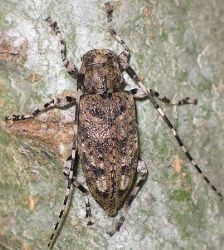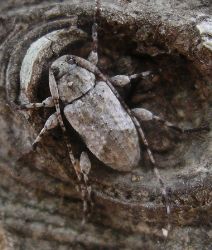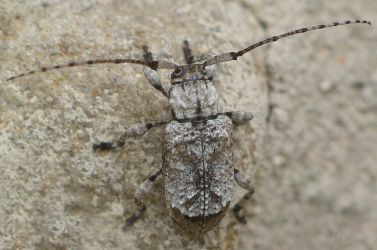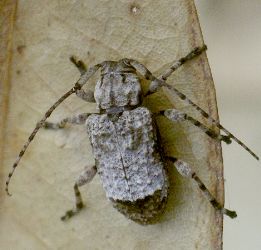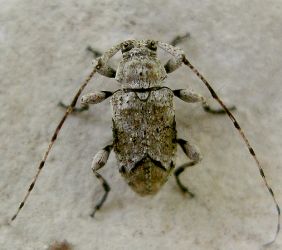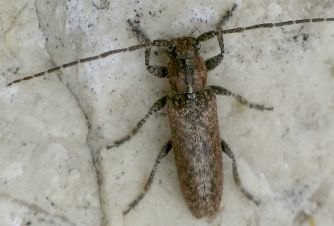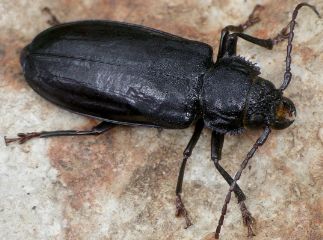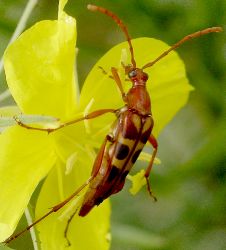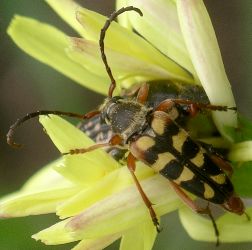
| Cerambycidae ~ Longhorn Beetles |
|
A good number of Lamiinae species are rather small, more compact and bullet-shaped than most other longhorns, and have various mottled brown/tan/white/black markings, which can sometimes be variable among individuals of the same species. Their antennae are often very long and banded with black and white and the insects hold them back when hiding or resting. They range in size from 8-12 mm and the femurs are enlarged. I frequently find these species on the bark of various trees, especially in our yard. The cryptic markings certainly help the beetles blend in with tree bark.
Sternidius variegatus has a rather shiny texture with many dimples in the elytra. The markings on the elytra appear rather complex, but the white oval near the rear of each is a good clue. Another small compact species is Ecyrus dasycerus. The texture of this beetle's elytra is very bumpy and sort of felt-like. There are distinctive black bars near the front of the elytra but otherwise there are very few distinguishing coloration clues on this one.
Styloleptus biustus is one of the smallest of this group. It has velvety elytra with very pronounced rows of bumps. The diagonal delineation between the dark rear and light front of the elytra is a good field mark. There are also dark blotches on the sides, but they are not very visible from above.
One of the most common species is Leptostylus transversus. I thought it's interesting how the genus names Leptostylus and Styloleptus are simply rearranged syllables. Anyway, L. transversus has variable markings on very bumpy elytra, with the back dark bit being about the most consistent. There can also be diagonal dark marks but these aren't always obvious. The pronotum of this one has dark streaks. Although very similar to other species, the pronotum of Liopinus mimeticus has rather extended ridges on the sides. This beetle also has dark blotches on the sides of the body, as well as a dark arrow shape (pointing forward) near the rear.
An attractive larger member of this same group is Graphisurus trangulifera. This genus was formerly called Urographis and the name has only recently been changed. The length is about 13 mm and the females have a stick-like ovipositor. While the markings on the fairly smooth, matte body can vary, they are always quite clear and ornate. While many species in this subfamily are sort of short and wide, one happens to look more long, slender, and plain, much like many members of the Cerambycinae. Ataxia crypta is about 12 mm long, fairly slender, and has a mottled color pattern that looks much like sand granules of white, reddish brown, and gray mixed together. The result is that it appears to be almost uniformly colored until viewed very closely. Further obscuring any obvious pattern are the hairiness and the numerous small punctures on the elytra. Clues that help with identification include the small white marks on the scutellum and center of the pronotum.
There is one longhorn beetle that can easily be mistaken for a darkling beetle of the genus Eleodes and that is Moneilema armatum, the Cactus Longhorn. This 18-20 mm long black beetle is usually seen either on cactus or on the ground near them. It is very heavily built, with a rather flat black appearance. There are white streaks on the legs and antennal segments, with a white band that encircles the middle of each antenna.
I've only found one species in the subfamily Prioninae, the tooth-necked longhorns, a group containing some of our largest beetles. However, the Hardwood Stump Borer (Mallodon dasytomus) is a very impressive insect and not easily mistaken for anything else. The females can be around 40 mm long while the males are a little smaller. They are solid dark brown or black. The females have very serrated edges on their pronotums while the males' are less so. The males have sculpted markings on their pronotums that are lacking on the females'. Males also have large mandibles, but females are so big that they can also give a nasty bite if held the wrong way. The larvae of these beetles take several years to mature.
Although I earlier mentioned that several species of longhorn beetles feed at flowers, there is a subfamily called the flower longhorns (Lepturinae). I've only found a few species in our area, but they can be quite numerous during the late spring. The shape of the flower longhorns is distinctive, with a body that is widest at the shoulders, tapering to a point at the rear and often curving downwards at both ends: the perfect shape for feeding at blossoms. Antennae are not exceedingly long. These beetles are generally wasp mimics and their colors and flight/feeding habits reflect that.
The most common species is Strangalia virilis. Not only is the name pretty cool, but the males of this species have a unique projection on the tip of their abdomen. The females are more strongly marked, a bit heavier, and of course lack the weird structure at the back. S. virilis is about 12-20 mm long, very slender, and feeds at a wide variety of flowers. While the male colors are more reddish and yellow, the females tend to have darker brown markings.
Strangalia sexnotata is a smaller species and the male lacks the odd abdominal projection. The colors are even more reddish but again the female has stronger markings than the male and is also distinctly wider. I see this species more infrequently but at the same time of year as S. virilis. It might just be coincidence, but I have only found it feeding at Coreopsis flowers.
One other species flies at the same time and that is Typocerus sinuatus. These longhorns are a little heftier in build than Strangalia and the markings are black along with reddish and yellow colors. The amount of black vs. yellow is variable. Behavior is much the same for all the flower longhorns, as they feed alongside other spring flower opportunists such as scarabs, bees and wasps. |
![]()
